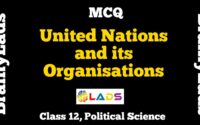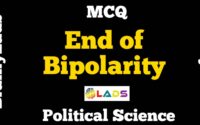MCQ Of India’s Foreign Policy | Class 12 | Political Science | Term 1 |
MCQ Of India’s Foreign Policy | Class 12 | Political Science | Term 1 |
1) Directive principles of state policy on ‘Promotion of international peace and security’ are mentioned in which article of the Indian constitution?
a) Article 55
b)Article 52
c)Article 51
d)Article 53
ANSWER – Article 51
2) Which of the following was not an objective of Nehru’s foreign policy?
a) Promote rapid economic development
b) Protect territorial integrity
c) Preserve the hard-earned monarchy
d) None of the above
ANSWER – Preserve the hard-earned monarchy
3) North Atlantic Treaty Organisation (NATO) was led by?
a) USSR
b) USA
c) Japan
d) Britain
ANSWER – USA
4) Which of the following was not among the founding members of NAM?
a) Nasser
b) Nkrumah
c) Lal Bahadur Shasri
d) Tito
ANSWER – Lal Bahadur Shastri
5) Full form of NAM is ________
a) Non-Aligned Movement
b) National Market Of Agriculture
c) Both A and B
d) None of the above
ANSWER – Non-Aligned Movement
6) Warsaw pact was led by _________
a) Soviet Union
b) USA
c) Australia
d) Italy
ANSWER – Soviet Union
7) Where was the first summit of NAM held?
a) Tehran
b) Shimla
c) Accra
d) Belgrade
ANSWER – Belgrade
8) Bandung conference was held in ________
a) Ghana
b) Egypt
c) Indonesia
d) Thailand
ANSWER- Indonesia
9) Which conference led to the establishment of NAM?
a) Belgrade conference
b) Tashkent conference
c) Shimla conference
d) Bandung conference
ANSWER – Bandung conference
10) first summit of NAM was held in Belgrade in _______
a) September 1961
b) March 1961
c) July 1962
d) April 1965
ANSWER – September 1961
You may also read Challenges of Nation Building, MCQ of Planning and Development for better understanding of the chapter and scoring higher.
11) Which agreement was signed between Prime Minister Jawaharlal Nehru and Chinese Premier Zhou Enlai on 29 April 1954?
a) Tashkent agreement
b) Tehran agreement
c) Panchsheel agreement
d) None of the above
ANSWER – Panchsheel agreement
12) Name the spiritual leader who crossed over into Indian border and sought asylum in India
a) Skal Bzang
b) Dalai Lama
c) Sukarno
d) Tito
ANSWER – Dalai Lama
13) Dalai lama has made ______ his home in India
a) Tibet
b) Dharamshala
c) Manali
d) Coorg
ANSWER – Dharamshala
14) Which is the largest refugee settlement of Tibetans in India?
a) Dharamshala (Himachal Pradesh)
b) McLeod Ganj (Himachal Pradesh)
c) Manali (Himachal Pradesh)
d) Gangtok (Sikkim)
ANSWER – Dharamshala (Himachal Pradesh)
15) Full form of NEFA is
a) North Atlantic Treaty Organisation
b) North Eastern Frontier Agency
c) Both A and B
d) None of the above
ANSWER – North Eastern Frontier Agency
16) The Panchsheel agreement was signed between _______ and ________
a) Indira Gandhi and Zulfikar Ali Bhutto
b) Lal Bahadur Shastri and Yahya Khan
c) Jawaharlal Nehru and Zhou Enlai
d) None of these
ANSWER – Jawaharlal Nehru and Zhou Enlai
17) Name the two disputed areas between India and China
a) Jammu and Kashmir
b) Aksai chin and NEFA
c) Arunanchal Pradesh and Sikkim
d) Ladakh and Uttrakhand
ANSWER – Aksai chin and NEFA
18) Which of the following statement is not true regarding Indo china war 1962?
a) China launched a swift and massive invasion in October 1962 on both the disputed regions
b) The China war dented India’s image at home and abroad
c) While the Indian forces could block the Chinese advances on the western front in Ladakh in the east the Chinese managed to advance nearly to the entry point of Assam plains
d) None f the above
ANSWER –None of the above
19) Who was the defence minister at the time of Indo china war 1962?
a) V.Krishna Menon
b) Manohar Parrikar
c) Jagjivan Ram
d) Yashwantro Chavan
ANSWER – V. Krishna Menon
20) Who was the first Prime Minister to visit China after the Indo-China War?
a) Jawaharlal Nehru
b) Lal Bahadur Shastri
c) Indira Gandhi
d) Rajiv Gandhi
ANSWER – Rajiv Gandhi
21) Who was first top level leader (external affairs minister) to visit China in 1979?
a) Sardar Vallabhai Patel
b) Lal Krishna Advani
c) Atal Bihari Vajpayee
d) S. Jaishankar
ANSWER – Atal Bihari Vajpayee
22) Panchsheel agreement was signed on_______
a) 29 April 1954
b) 21 August 1956
c) 19 January 1953
d) 25 April 1954
ANSWER – 29 April 1954
23) Why the no confidence motion against government was moved in 1963?
a) Because of the farm protests
b) Because of the Indo China war
c) Because of the Indo Pak war
d) None of the above
ANSWER – Because of the Indo China war
24) Which treaty was signed between India and Pakistan through the mediation of World Bank?
a) Treaty of Lahore
b) Treaty of Amritsar
c) Indus water Treaty
d) Ganga water treaty
ANSWER – Indus water treaty
25) Who was the second prime minister of India?
a) Lal Bahadur shastri
b) Indira Gandhi
c) Rajendra Prasad
d) V.K. Menon
ANSWER – Lal Bahadur Shastri
26) Tashkent agreement was signed between ________and _________
a) Indira Gandhi and Zulfikar Ali Bhutto
b) Jawaharlal Nehru and Ayub Khan
c) Rajendra Prasad and Yahya Khan
d) Lal Bahadur Shastri and Ayub Khan
ANSWER – Lal Bahadur Shastri and Ayub Khan
27) Awami league was led by _________
a) Zulfikar Ali Bhutto
b) Sheikh Mujib-Ur Rahman
c) Ziaur Rahman
D) H.M. Ershad
ANSWER – Sheikh Mujib-Ur Rahman
28) In August 1971, India signed a 20 year peace and friendship treaty with _________
a) USA
b) Pakistan
c) Soviet Union
d) Bangladesh
ANSWER – Soviet Union
29) Shimla agreement was signed between ________ and_________
a) Lal Bahadur Shastri and Zhou Enlai
b) Indira Gandhi and Zulfikar Ali Bhutto
c) V.P. Mandal and Sheikh Mujib-ur Rahman
d) None of the above
ANSWER – Indira Gandhi and Zulfikar Ali Bhutto
30) Indus water treaty was signed in 1960 between ________
a) India and Pakistan
b) India and Bangladesh
c) Pakistan and Bangladesh
d) India and Afghanistan
ANSWER – India and Pakistan
31) Which of the following is not among the 5 nuclear weapon states?
a) China
b) France
c) Russia
d) Bangladesh
ANSWER – Bangladesh
32) When was the Shimla agreement signed?
a) 4 July 1972
b) 10 July 1973
c) 3 July 1972
d) 15 July 1972
ANSWER – 3 July 1972
33) When was the first nuclear explosion undertaken by India?
a) May 1974
b) August 1975
c) July 1974
d) February 1973
ANSWER – May 1974
34) Which of the following was not a reason of bitterness between India and China in 1962?
a)Tibet issue
b) Boundary dispute
c) Water dispute
d) Both B and C
ANSWER – Water Dispute
35) Who was the first female prime minister of India?
a) Indira Gandhi
b) Kamla Nehru
c) Pratibha Patil
d) Anandiben Patel
ANSWER – Indira Gandhi
36) Why India did not signed Non-proliferation treaty?
a) Because of the protests of Indian industrialists
b) India considered it to be discriminatory
c) Both A and B
d) None of the above
ANSWER- India considered it to be discriminatory
37) Which statement is true about Indo – Pak war 1965?
a) Pakistan launched armed attacks in the Rann of Kutch area of Gujarat
b) Indian army reached close to Lahore
C) Prime minister Lal Bahadur Shastri ordered Indian troops to launch a counter-offensive on the Punjab border
d) All of the above
ANSWER – All of the above
38) Name the war fought between India and Pakistan in 1999?
a) Kashmir war
b) Kargil war
c) Indo-Pak war
d) None of the above
ANSWER – Kargil War
39) What is the full form of CTBT?
a) Comprehensive Taste Ban Treaty
b) Compulsive Test Ban Treaty
c) Comprehensive Test Ban Treaty
d) None of the above
ANSWER – Comprehensive Test Ban Treaty
40) Which of the following was not among the areas occupied by Pakistan in the Kargil War?
a) Dras
b) Kaksar
c) Mashkoh
d) Doda
ANSWER – Doda
41) What was the duration of peace and friendship treaty signed between India and Soviet Union?
a) 15 years
b) 20 years
c) 10 years
d) 25 years
ANSWER – 20 years
42) Who tried to impose the Nuclear Non-proliferation Treaty of 1968 on the rest of the world?
a) UN Security Council
b) UN General Assembly
c) International Court Of Justice
d) None of the above
ANSWER – UN Security Council
43) Who was worried about a possible Chinese aggression in future?
a) Jawaharlal Nehru
b) Sardar Vallabhai Patel
c) Lal Bahadur Shastri
d) Atal Behari Vajpayee
ANSWER – Sardar Vallabhai Patel
44) Britain attacked Egypt in 1956 over_______
a) Suez Canal issue
b) Panama Canal issue
c) Corinth Canal issue
d) White sea-Baltic Canal issue
ANSWER – Suez Canal issue
45) When did China attack Tibet?
a) 1960
b) 1950
c) 1952
d) 1955
ANSWER – 1950
Related
Do share the post if you liked the MCQ of India’s Foreign Policy. For more updates, keep logging on BrainyLads



Bst material for term 1 exam cbse board
Question number 20 should be Who was the first Prime Minister to visit China after the Indo-China War